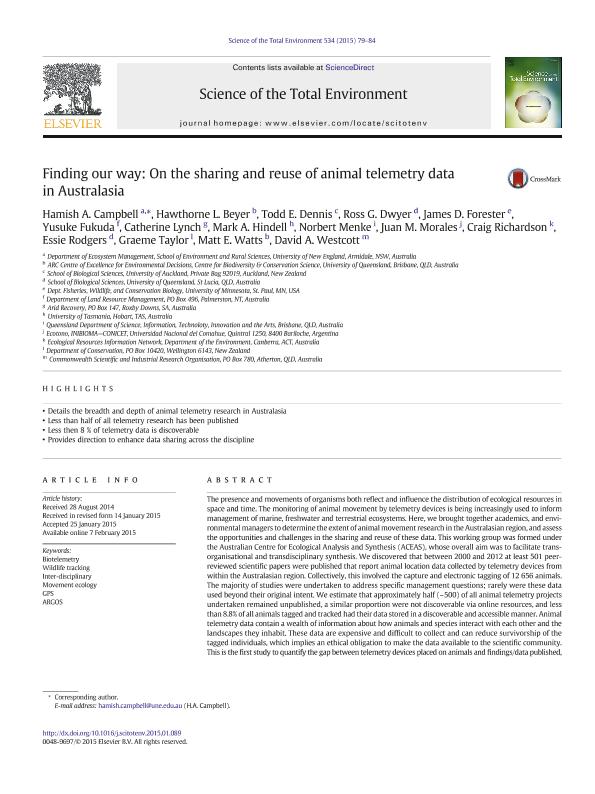Mostrar el registro sencillo del ítem
dc.contributor.author
Campbell, Hamish A.
dc.contributor.author
Beyer, Hawthorne L.
dc.contributor.author
Dennis, Todd E.
dc.contributor.author
Dwyer, Ross G.
dc.contributor.author
Forester, James D.
dc.contributor.author
Fukuda, Yusuke
dc.contributor.author
Lynch, Catherine
dc.contributor.author
Hindell, Mark A.
dc.contributor.author
Menke, Norbert
dc.contributor.author
Morales, Juan Manuel

dc.contributor.author
Richardson, Craig
dc.contributor.author
Rodgers, Essie
dc.contributor.author
Taylor, Graeme
dc.contributor.author
Watts, Matt E.
dc.contributor.author
Westcott, David A.
dc.date.available
2017-01-31T19:26:15Z
dc.date.issued
2015-11
dc.identifier.citation
Campbell, Hamish A.; Beyer, Hawthorne L. ; Dennis, Todd E.; Dwyer, Ross G. ; Forester, James D.; et al.; Finding our way: on the sharing and reuse of animal telemetry data in Australasia; Elsevier Science; Science Of The Total Environment; 534; 11-2015; 79-84
dc.identifier.issn
0048-9697
dc.identifier.uri
http://hdl.handle.net/11336/12260
dc.description.abstract
The presence and movements of organisms both reflect and influence the distribution of ecological resources in space and time. The monitoring of animal movement by telemetry devices is being increasingly used to inform management of marine, freshwater and terrestrial ecosystems. Here, we brought together academics, and environmental managers to determine the extent of animal movement research in the Australasian region, and assess the opportunities and challenges in the sharing and reuse of these data. This working group was formed under the Australian Centre for Ecological Analysis and Synthesis (ACEAS), whose overall aim was to facilitate trans-organisational and transdisciplinary synthesis. We discovered that between 2000 and 2012 at least 501 peer-reviewed scientific papers were published that report animal location data collected by telemetry devices from within the Australasian region. Collectively, this involved the capture and electronic tagging of 12 656 animals. The majority of studies were undertaken to address specific management questions; rarely were these data used beyond their original intent. We estimate that approximately half (~ 500) of all animal telemetry projects undertaken remained unpublished, a similar proportion were not discoverable via online resources, and less than 8.8% of all animals tagged and tracked had their data stored in a discoverable and accessible manner. Animal telemetry data contain a wealth of information about how animals and species interact with each other and the landscapes they inhabit. These data are expensive and difficult to collect and can reduce survivorship of the tagged individuals, which implies an ethical obligation to make the data available to the scientific community. This is the first study to quantify the gap between telemetry devices placed on animals and findings/data published, and presents methods for improvement. Instigation of these strategies will enhance the cost-effectiveness of the research and maximise its impact on the management of natural resources.
dc.format
application/pdf
dc.language.iso
eng
dc.publisher
Elsevier Science

dc.rights
info:eu-repo/semantics/openAccess
dc.rights.uri
https://creativecommons.org/licenses/by-nc-nd/2.5/ar/
dc.subject
Biotelemetry
dc.subject
Wildlife Tracking
dc.subject
Inter-Disciplinary
dc.subject
Movement Ecology
dc.subject.classification
Ecología

dc.subject.classification
Ciencias Biológicas

dc.subject.classification
CIENCIAS NATURALES Y EXACTAS

dc.title
Finding our way: on the sharing and reuse of animal telemetry data in Australasia
dc.type
info:eu-repo/semantics/article
dc.type
info:ar-repo/semantics/artículo
dc.type
info:eu-repo/semantics/publishedVersion
dc.date.updated
2016-12-12T14:23:18Z
dc.journal.volume
534
dc.journal.pagination
79-84
dc.journal.pais
Países Bajos

dc.journal.ciudad
Amsterdam
dc.description.fil
Fil: Campbell, Hamish A.. University of New England; Australia
dc.description.fil
Fil: Beyer, Hawthorne L. . University Of Queensland; Australia
dc.description.fil
Fil: Dennis, Todd E.. The University Of Auckland; Nueva Zelanda
dc.description.fil
Fil: Dwyer, Ross G. . University Of Queensland; Australia
dc.description.fil
Fil: Forester, James D.. University Of Minnesota; Estados Unidos
dc.description.fil
Fil: Fukuda, Yusuke . Department of Land Resource Management; Australia
dc.description.fil
Fil: Lynch, Catherine . Arid Recovery; Australia
dc.description.fil
Fil: Hindell, Mark A. . University Of Tasmania; Australia
dc.description.fil
Fil: Menke, Norbert . Queensland Department of Science, Information, Technology, Innovation and the Arts; Australia
dc.description.fil
Fil: Morales, Juan Manuel. Universidad Nacional del Comahue. Centro Regional Universitario Bariloche. Laboratorio de Ecotono; Argentina. Consejo Nacional de Investigaciones Científicas y Técnicas. Centro Científico Tecnológico Patagonia Norte. Instituto de Investigación en Biodiversidad y Medioambiente; Argentina
dc.description.fil
Fil: Richardson, Craig . Department of the Environment; Australia
dc.description.fil
Fil: Rodgers, Essie. University Of Queensland; Australia
dc.description.fil
Fil: Taylor, Graeme . Department of Conservation; Nueva Zelanda
dc.description.fil
Fil: Watts, Matt E. . University Of Queensland; Australia
dc.description.fil
Fil: Westcott, David A.. Commonwealth Scientific and Industrial Research Organisation; Australia
dc.journal.title
Science Of The Total Environment

dc.relation.alternativeid
info:eu-repo/semantics/altIdentifier/doi/http://dx.doi.org/10.1016/j.scitotenv.2015.01.089
dc.relation.alternativeid
info:eu-repo/semantics/altIdentifier/url/http://www.sciencedirect.com/science/article/pii/S0048969715001114
Archivos asociados
